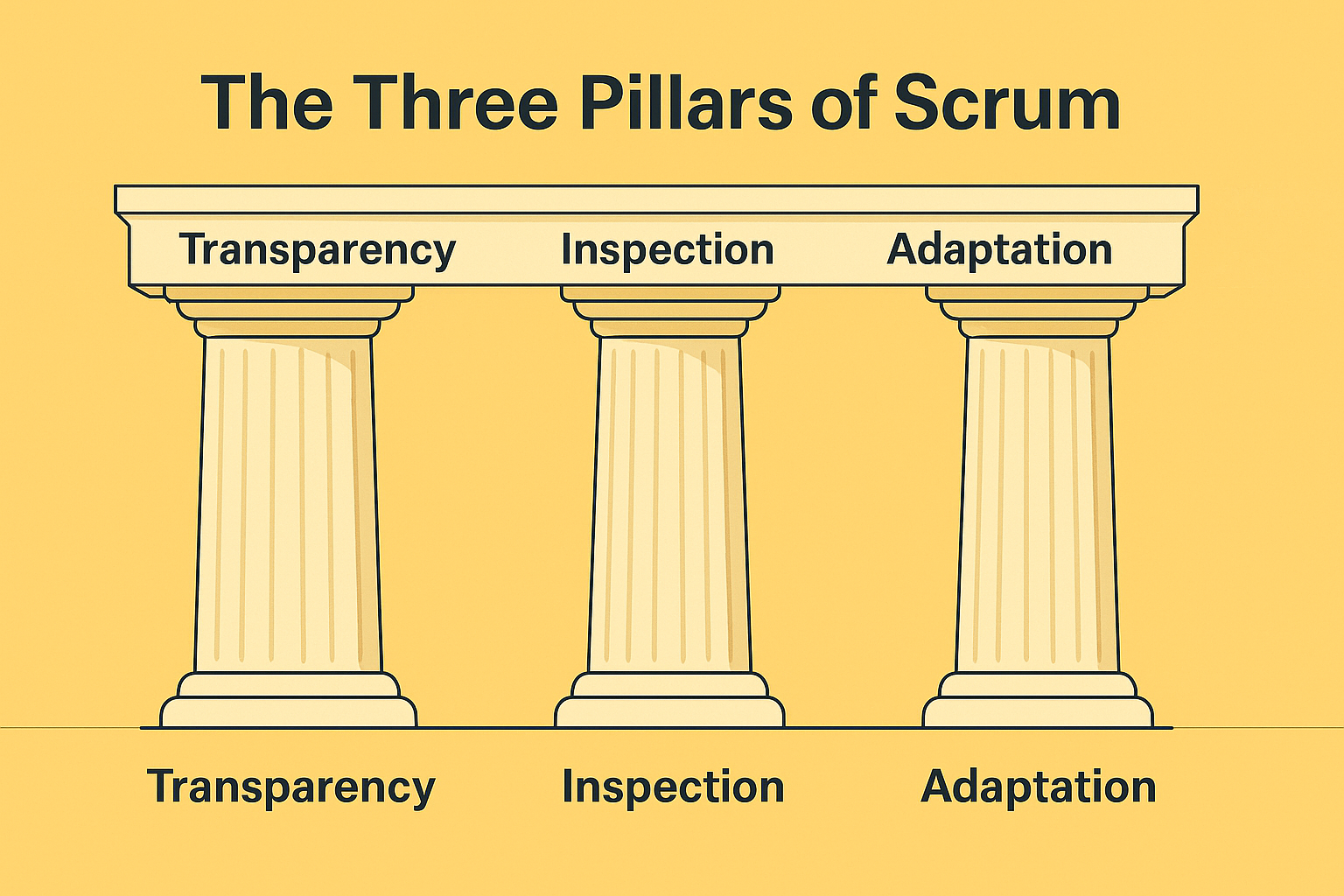Scrum is not just a framework for Agile project management—it’s a mindset rooted in empiricism. At its core, Scrum is built on three foundational pillars: Transparency, Inspection, and Adaptation. These principles guide Scrum Teams in navigating complex work, making informed decisions, and continuously improving. In this blog, we’ll explore each pillar in detail and see how Scrum’s events and artifacts uphold and enable them in practice.
1. Transparency – Building a Shared Understanding
Transparency means that all aspects of the process that affect the outcome must be visible to those managing the work. Everyone involved—Product Owner, Scrum Master, Developers, and stakeholders—must share a common understanding of what is being worked on, how progress is measured, and what “done” means.
Without transparency, inspection and adaptation are pointless or misinformed. If stakeholders don't see the real progress or understand the true state of the product, decisions made based on faulty assumptions can lead to poor outcomes.
Artifacts play a crucial role in maintaining transparency:
- Product Backlog: This is the single source of truth for everything the team might work on. It reflects evolving customer needs and product direction.
- Sprint Backlog: This shows the plan for the current Sprint, including selected Product Backlog Items and the plan to deliver them.
- Increment: This is the sum of all completed Product Backlog Items at the end of a Sprint. It's a transparent measure of what has been accomplished.
Events also promote transparency:
- Sprint Planning: Everyone aligns on what will be delivered and how. The team commits to a Sprint Goal and selects work accordingly.
- Daily Scrum: A 15-minute daily sync where Developers share progress and make their work visible to one another.
- Sprint Review: The product is demonstrated to stakeholders, promoting openness and shared understanding of the progress.
- Sprint Retrospective: Even the process is made transparent. Teams reflect on how they worked and identify improvements.
Through these mechanisms, Scrum removes ambiguity. It encourages clarity and alignment, allowing everyone to make better decisions based on facts, not assumptions.
2. Inspection – Detecting Deviations Early
Inspection means frequently examining Scrum artifacts and progress to detect undesirable variances. But inspection is only useful when it's done diligently and by skilled individuals who know what to look for.
Frequent inspections prevent issues from snowballing and enable timely interventions. It’s not about micromanagement but about creating checkpoints to course-correct when needed.
Scrum includes multiple inspection points throughout the Sprint:
- Daily Scrum: Teams inspect their progress toward the Sprint Goal and adjust the Sprint Backlog as necessary.
- Sprint Review: This is a collaborative inspection of the Increment with stakeholders. It allows feedback, market insights, and changes in direction to be considered.
- Sprint Retrospective: The team inspects itself—their practices, collaboration, tools, and environment. It fosters introspection and identifies improvements.
- Backlog Refinement (though not an official event): This recurring activity helps inspect and clarify upcoming work.
The artifacts also support inspection:
- The Increment shows what’s been accomplished.
- The Product Backlog reflects emerging requirements and ongoing prioritization.
- The Sprint Backlog allows for inspection of progress and plan adjustments.
Inspection in Scrum is never about blame—it’s about learning. When done with openness and objectivity, it drives continuous progress.
3. Adaptation – Embracing Change and Learning
Adaptation means adjusting the process or product as soon as possible when deviations are detected. In a world of complexity and unpredictability, the ability to adapt is a competitive advantage.
Scrum’s design assumes that we won’t get everything right the first time. Instead, it enables frequent, small changes that help teams stay aligned with customer needs and market realities.
Adaptation is the natural follow-up to inspection. Once something is observed—whether a problem, an opportunity, or a lesson learned—the team can adjust.
Scrum’s events are built with adaptation in mind:
- Daily Scrum: Enables teams to adjust their approach daily.
- Sprint Review: Stakeholder feedback can lead to Product Backlog changes.
- Sprint Retrospective: Leads to actionable process improvements.
- Sprint Planning: Allows the team to adapt their strategy based on previous Sprint results.
The Product Owner adapts the Product Backlog based on new insights. The Scrum Team adapts the Sprint Backlog as work progresses. The Scrum Master helps the team improve its way of working.
Together, these adaptive behaviors ensure that the team is always improving—not only in terms of the product but in how they build it.
Why These Pillars Matter
The three pillars of Scrum are not just theoretical constructs. They are practical principles that help Scrum Teams succeed in real-world, complex environments. Let’s revisit why they matter:
- Without transparency, you cannot trust the information you're working with.
- Without inspection, you cannot identify what’s going wrong or what could be improved.
- Without adaptation, you’re doomed to repeat mistakes and fall behind changing needs.
Scrum doesn’t give you certainty—it gives you a system to navigate uncertainty.
Conclusion: Anchoring Success in Empiricism
The three pillars of Scrum—Transparency, Inspection, and Adaptation—are the foundation of empirical process control. Scrum does not promise instant success or guaranteed outcomes. Instead, it provides a structured yet flexible way to continuously inspect and adapt both product and process.
Each Scrum event and artifact is purposefully designed to support these pillars. When used properly, they help teams stay aligned, learn from experience, and incrementally deliver real value.
Whether you're a Product Owner ensuring transparency in the backlog, a Scrum Master fostering inspection in retrospectives, or a Developer adapting daily tasks based on feedback—understanding and embodying these pillars is key to thriving in Scrum.
